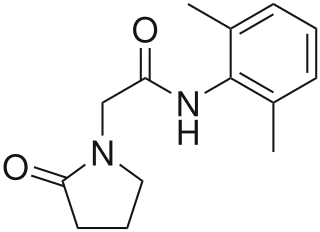
Nootropics are numerous natural or synthetic supplements or drugs and other substances that are claimed to improve cognitive function or to promote relaxation, particularly boosting mood, executive functions, attention, memory, creativity, or motivation in healthy individuals.

Oxiracetam is a nootropic drug of the racetam family and a very mild stimulant. Several studies suggest that the substance is safe even when high doses are consumed for a long period of time. However, the mechanism of action of the racetam drug family is still a matter of research. Oxiracetam is not approved by Food and Drug Administration for any medical use in the United States.

Nefiracetam is a nootropic drug of the racetam family. Preliminary research suggests that it may possess certain antidementia properties in rats.

Meclofenoxate is a cholinergic nootropic used as a dietary supplement. It is an ester of dimethylethanolamine (DMAE) and 4-chlorophenoxyacetic acid (pCPA).
Racetams are a class of drugs that share a pyrrolidone nucleus. Some, such as piracetam, aniracetam, oxiracetam, pramiracetam and phenylpiracetam are considered nootropics. Others such as levetiracetam, brivaracetam, and seletracetam are anticonvulsants.

CX-516 is an ampakine and nootropic that acts as an AMPA receptor positive allosteric modulator and had been undergoing development by a collaboration between Cortex, Shire, and Servier. It was studied as a potential treatment for Alzheimer's disease under the brand name Ampalex, and was also being examined as a treatment for ADHD.
Fipexide is a psychoactive drug of the piperazine chemical class which was developed in Italy in 1983. It was used as a nootropic drug in Italy and France, mainly for the treatment of senile dementia, but is no longer in common use due to the occurrence of rare adverse drug reactions including fever and hepatitis. Fipexide is similar in action to other nootropic drugs such as piracetam and has a few similarities in chemical structure to centrophenoxine. Chemically, it is an amide union of parachlorophenoxyacetate and methylenedioxybenzylpiperazine (MDBZP), and has been shown to metabolize to the latter, which plays a significant role in its effects.

Farampator is an ampakine drug. It was developed by Cortex Pharmaceuticals, and licensed to Organon BioSciences for commercial development. Following the purchase of Organon by Schering-Plough in 2007, the development license to farampator was transferred. The development of farampator was eventually terminated, reportedly due to concerns about cardiac toxicity.
Adrenergic means "working on adrenaline (epinephrine) or noradrenaline (norepinephrine)". When not further qualified, it is usually used in the sense of enhancing or mimicking the effects of epinephrine and norepinephrine in the body.

Razobazam (INN) is a drug which is a benzodiazepine derivative. Its mechanism of action appears to be quite different from that of most benzodiazepine drugs, and it produces nootropic effects in animal studies.

L-655,708 (FG-8094) is a nootropic drug invented in 1996 by a team working for Merck, Sharp and Dohme, that was the first compound developed which acts as a subtype-selective inverse agonist at the α5 subtype of the benzodiazepine binding site on the GABAA receptor. It acts as an inverse agonist at the α1, α2, α3 and α5 subtypes, but with much higher affinity for α5, and unlike newer α5 inverse agonists such as α5IA, L-655,708 exerts its subtype selectivity purely via higher binding affinity for this receptor subtype, with its efficacy as an inverse agonist being around the same at all the subtypes it binds to.

Cyclazodone is a centrally acting stimulant drug developed by American Cyanamid Company in the 1960s. The drug is related to other drugs such as pemoline and thozalinone. It displayed a favorable therapeutic index and margin of safety in comparison to Pemoline and other N-lower-alkyl-substituted Pemoline derivatives. The patents concluded that Cyclazodone possessed properties efficacious in reducing fatigue and as a potential anorectic. Structural congeners of Pemoline have been described as "excitants with unique properties distinguishing them from the sympathomimetic amines" whilst displaying less stimulatory activity and toxicity compared to amphetamine.

Corneliu E. Giurgea was a Romanian psychologist and chemist. In 1964 he synthesised Piracetam, which he has described as a nootropic.

Adafenoxate is a compound related to centrophenoxine, that has been found to act as a nootropic in rats.

N-Phenylacetyl-l-prolylglycine ethyl ester is promoted as a nootropic and is a prodrug of cyclic glycine-proline. Other names include the brand name Noopept, developmental code GVS-111; proposed INN omberacetam.

Sunifiram is an experimental drug which has antiamnesic effects in animal studies and with significantly higher potency than piracetam. Sunifiram is a molecular simplification of unifiram (DM-232). Another analogue is sapunifiram (MN-19). As of 2016, sunifiram had not been subjected to toxicology testing, nor to any human clinical trials, and is not approved for use anywhere in the world.

Unifiram is an experimental drug. that has antiamnesic and other effects in animal studies with far greater potency than piracetam. A number of related compounds are known, such as sunifiram (DM-235) and sapunifiram (MN-19). Unifiram has two enantiomers, with the dextro form being the more active isomer. It has been shown to reduce the duration of hypnosis induced by pentobarbital, without impairing motor coordination. As of 2015, no formal human studies with unifiram have been conducted. Unifiram is not patented and, despite the lack of human and long-term toxicity studies, it is commonly sold online.

Selank is a nootropic, anxiolytic peptide based drug developed by the Institute of Molecular Genetics of the Russian Academy of Sciences. Selank is a heptapeptide with the sequence Thr-Lys-Pro-Arg-Pro-Gly-Pro (TKPRPGP). It is a synthetic analogue of human tuftsin.

Ro10-5824 is a drug which acts as a dopamine receptor partial agonist selective for the D4 subtype, and has nootropic effects in animal studies.

Terbequinil (SR-25776) is a stimulant and nootropic drug which acts as a partial inverse agonist at benzodiazepine sites on the GABAA receptor. In human trials it was found to partially reverse the sedative and amnestic effects of the hypnotic drug triazolam with only slight effects when administered by itself.


















